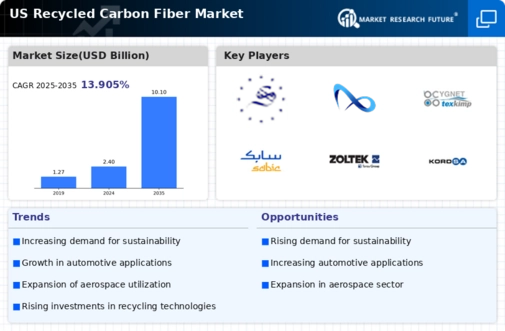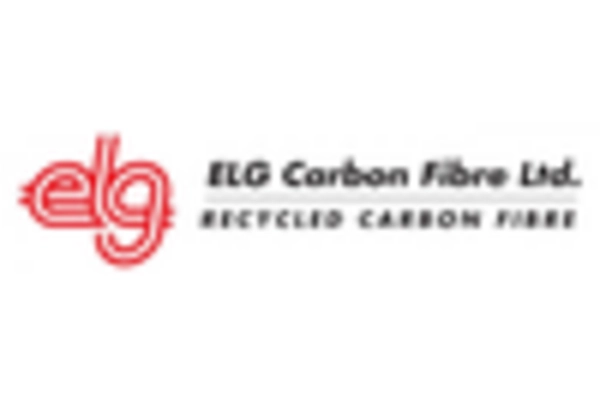Increasing Environmental Awareness
The rising consciousness regarding environmental sustainability is a pivotal driver for the recycled carbon-fiber market. As consumers and industries alike become more aware of the ecological impact of their choices, there is a marked shift towards sustainable materials. This trend is particularly pronounced in sectors such as automotive and aerospace, where the demand for lightweight, durable materials is coupled with a need for eco-friendly alternatives. The recycled carbon-fiber market is poised to benefit from this shift, as companies seek to reduce their carbon footprints. In fact, studies indicate that the use of recycled carbon fiber can reduce greenhouse gas emissions by up to 30%. This growing environmental awareness is likely to propel the market forward, as stakeholders prioritize sustainability in their procurement processes.
Technological Innovations in Recycling
Advancements in recycling technologies are playing a crucial role in shaping the recycled carbon-fiber market. Innovations such as chemical recycling and advanced sorting techniques are enhancing the efficiency and effectiveness of carbon fiber recycling processes. These technologies not only improve the quality of recycled materials but also expand the range of applications for recycled carbon fiber. For instance, the introduction of new methods has increased the recovery rate of carbon fibers from composite materials, making it feasible to recycle previously non-recyclable products. As these technologies continue to evolve, they are expected to unlock new opportunities within the recycled carbon-fiber market, potentially increasing its market share in various industries.
Cost-Effectiveness of Recycled Materials
The economic advantages associated with recycled materials are increasingly influencing the recycled carbon-fiber market. As production costs for virgin carbon fiber remain high, the recycled alternative presents a more affordable option for manufacturers. The cost of producing recycled carbon fiber can be up to 50% lower than that of new carbon fiber, making it an attractive choice for industries looking to optimize their budgets. This cost-effectiveness is particularly appealing in sectors such as construction and automotive, where material costs significantly impact overall project budgets. As companies strive to maintain profitability while adhering to sustainability goals, the recycled carbon-fiber market is likely to see heightened interest and investment, further driving its growth.
Growing Applications in Emerging Industries
The expansion of the recycled carbon-fiber market is also driven by its increasing applications in emerging industries. Sectors such as renewable energy, sports equipment, and consumer goods are beginning to recognize the benefits of incorporating recycled carbon fiber into their products. For instance, the wind energy sector is utilizing recycled carbon fiber in turbine blades, which require lightweight yet strong materials. This trend is indicative of a broader movement towards sustainability across various industries. As the demand for innovative and eco-friendly products continues to rise, the recycled carbon-fiber market is expected to grow, driven by its versatility and performance characteristics.
Government Incentives for Recycling Initiatives
Government policies and incentives aimed at promoting recycling initiatives are significantly impacting the recycled carbon-fiber market. Various federal and state programs are designed to encourage the use of recycled materials through tax credits, grants, and subsidies. These initiatives not only support manufacturers in adopting sustainable practices but also stimulate demand for recycled carbon fiber. For example, the implementation of stricter regulations on waste management and recycling has led to increased investments in recycling infrastructure. As a result, the recycled carbon-fiber market is likely to experience growth as companies align their operations with government mandates and capitalize on available incentives.

















Leave a Comment